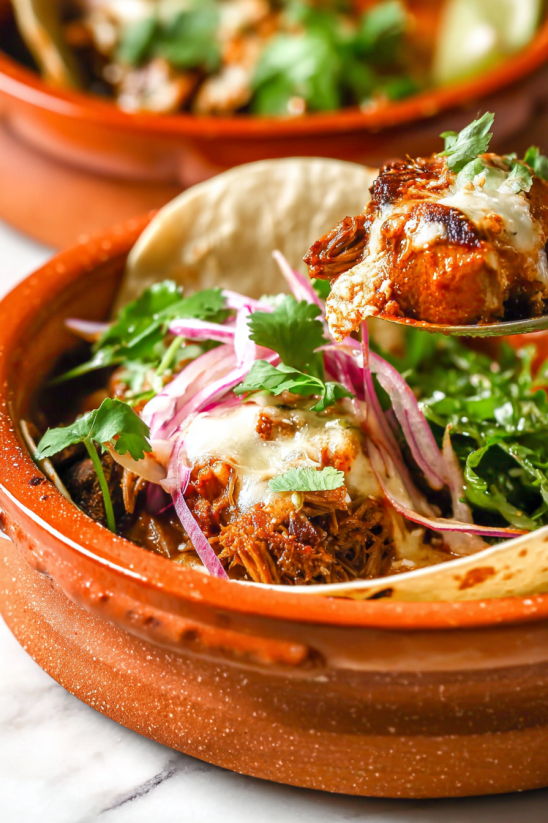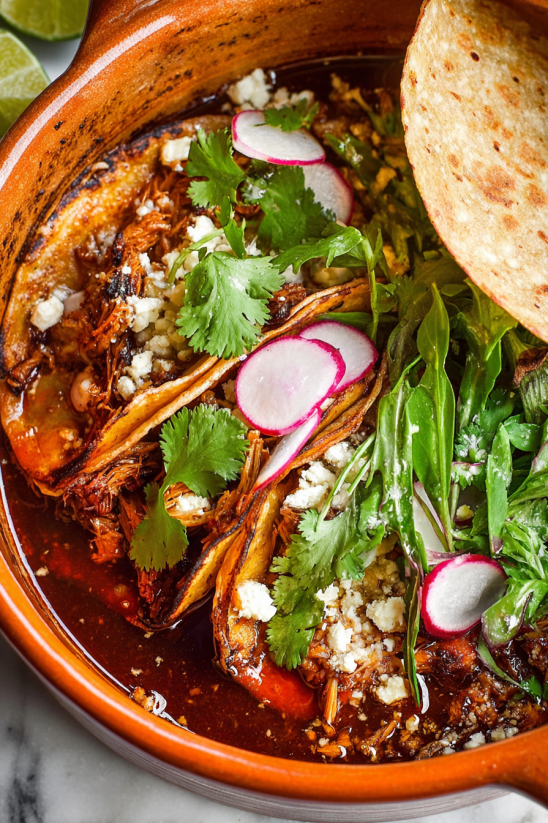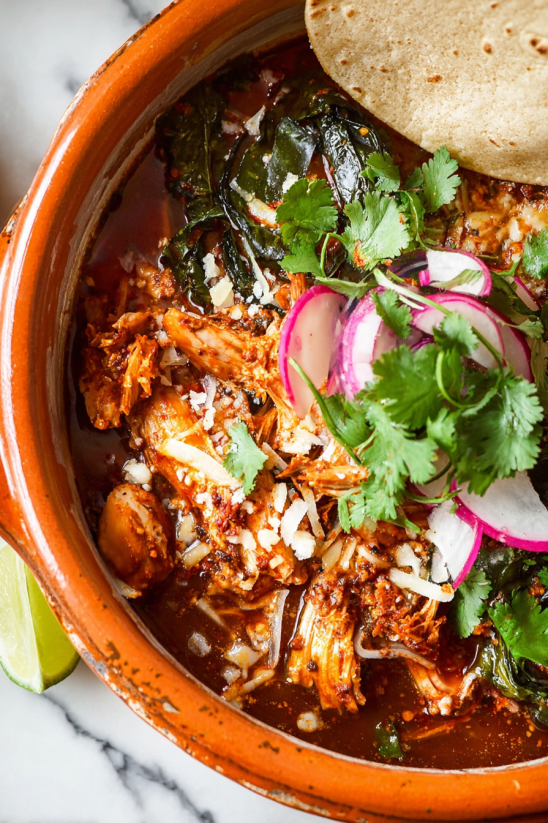 Save Pin
Save Pin
This vibrant pozole rojo brings together tender pork, fluffy hominy, and the unmistakable depth of dried Mexican chiles for a soul-warming celebration meal that honors its ancient roots. The irresistible combination of spicy broth and crunchy toppings is easier to capture in your kitchen than you might think. With just a little patience and some classic ingredients, you will have an inviting pot of red pozole perfect for sharing.
Every time I make pozole rojo, it feels like a holiday meal no matter the day. My family gathers with bowls in hand and the kitchen instantly smells like home.
Ingredients
- Boneless pork roast: Choose pork shoulder or butt for the most tender meat and rich flavor
- White onion: Use fresh, firm onions for their sweetness and aromatic qualities
- Garlic head: Fresh garlic cloves give the best sharp flavor depth dried powder does not compare
- Bay leaves: Pick dried leaves that are still green for a fragrant broth layer
- Chicken bouillon: Optional but it boosts the savory background of the soup
- Salt: Regular sea salt works but taste your broth as you go
- Mexican oregano: More robust and citrusy than Italian oregano this is a must for authenticity
- Dried guajillo chiles: Wide and mild with a beautiful brick red color try to find these whole in Latin markets
- Dried ancho chiles: Sweet mild and smoky these create body and subtle richness
- Water: You can use low sodium chicken or veggie broth instead for more flavor
- Canned hominy: Pre cooked is essential look for whole kernels with an intact creamy white color avoid dented cans
Step-by-Step Instructions
- Prepare the ingredients:
- Select a heavy pot or Dutch oven large enough to hold all the ingredients Lay your pork roast in the center of the pot along with peeled onion quartered for easy blending separated garlic cloves whole bay leaves chicken bouillon salt dried oregano dried guajillo and ancho chiles Add water to cover everything by at least two inches so the pork can simmer properly
- Simmer the soup:
- Bring the pot up to a gentle boil over medium heat then reduce to a low simmer Cover and cook slowly for about three hours Keep the heat low Skim off foam and impurities every thirty minutes to keep the broth clear About two and a half hours in find the bay leaves and remove them
- Blend the flavor base:
- Use tongs or a slotted spoon to lift out all the chiles onion garlic a half cup of hominy and a half cup of broth Place these in a blender Blend until very smooth This step gives your soup its signature color and body
- Return and season:
- Pour the blended mixture back into your soup pot Stir well to combine Let the soup gently simmer uncovered for one more hour Taste and adjust salt if needed Remove the pork from the pot shred or chop into bite sized pieces then return it to the soup
- Serve with toppings:
- Ladle the piping hot pozole into bowls Top generously with shredded cabbage fresh diced onion sliced radishes lime wedges and as many tostadas as you wish
 Save Pin
Save Pin
The dried guajillo chiles in this recipe are my personal favorite Their vibrant color and subtle fruitiness make the soup truly special My earliest memory of making pozole involves my grandmother instructing me never to rush the chile soaking This ritual always made it more than just a meal
Storage Tips
Pozole rojo keeps well for up to four days in the refrigerator for the freshest leftovers Store the soup and toppings separately so cabbage and radishes stay crunchy For longer storage the soup freezes beautifully in sturdy containers for up to three months Let it thaw overnight in the fridge before reheating Always reheat soup gently on the stovetop or microwave stirring often for even warmth
Ingredient Substitutions
If pork is not your choice bone in chicken thighs offer great texture and flavor Beef chuck is also a delicious but richer substitute For dried chiles pasilla can replace ancho if you wish If you do not have Mexican oregano regular oregano with a pinch of dried marjoram is a close match Vegetarian adaptation works by swapping the pork for mushrooms or jackfruit and using veggie broth and extra hominy
 Save Pin
Save Pin
Serving Suggestions
Pozole is the centerpiece of many Mexican celebrations often served with crispy tostadas a squeeze of lime tangy pickled jalapeños or even avocado slices My favorite way to eat it is with plenty of shredded cabbage and a hint of smoky salsa roja on top for even more heat
Cultural Roots
Pozole rojo traces back to prehispanic Mexico when it was offered at religious ceremonies and communal gatherings Its fiery color comes from indigenous red chiles and its symbolism as a shared dish lives on in Mexican families today Swapping human flesh for pork made it a beloved meal across the country while still respecting its ancient traditions
Commonly Asked Questions
- → What meat can I use for pozole rojo?
Pork shoulder or butt are traditional choices, but bone-in chicken thighs also work well for a lighter version.
- → What type of chiles are used?
Dried guajillo and ancho chiles form the base, giving the broth its signature color and mild, smoky flavor.
- → What is hominy and can it be swapped?
Hominy is corn kernels treated to become soft and puffy. Canned, pre-cooked hominy works best; dried can also be used with extra prep.
- → What toppings are essential for serving?
Classic options include shredded cabbage, sliced radishes, diced onion, lime wedges, and tostadas or tortilla chips.
- → How do I store leftovers?
Refrigerate leftovers in airtight containers for up to 4 days and keep toppings separate so they stay fresh and crunchy.
- → Can Pozole Rojo be made in a slow cooker?
Yes, simply combine all main ingredients and cook on HIGH for 4-5 hours or LOW for 7-8 hours until the meat is tender.
